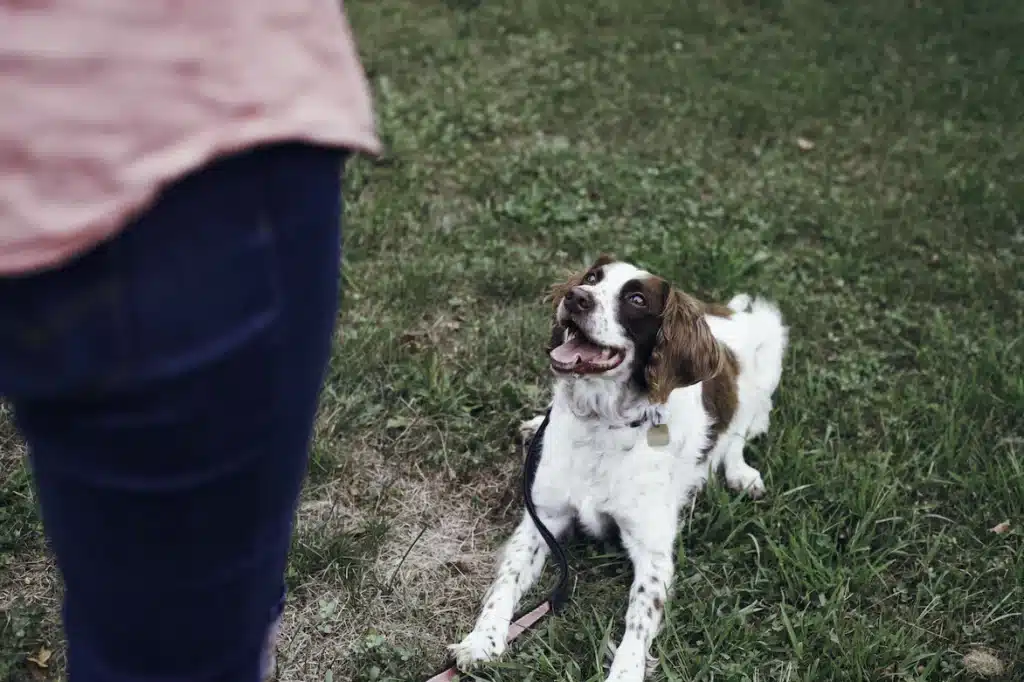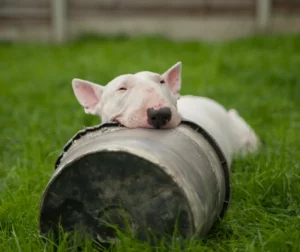The basic commands are essential to the education of dogs, especially puppies, to start on a good foundation. The younger he is, the easier it is to teach him commands.
Your dog needs a leader who will guide him to adopt the proper behavior. With love, patience, understanding, and forgiveness, you can create a solid bond.
In this article, you’ll learn about the techniques used to get your dog to master the basic commands, as well as the benefits of each one.
What Are the Basic Commands?
There are 6 basic commands every dog should know. These are the most important commands you can start teaching your dog or your puppy as soon as he arrives.
You can show him these commands as young as 6 weeks old. Before that, learning is unstable in puppies.
The basic commands are:
- Sit
- Down
- Stay
- Recall
- Loose leash walking
- Give it / let go
Warning: When you teach a command to your dog, the words used mustn’t have phonetic similarities. The words must mean something specific.
Why Is It Important to Teach Your Dog Basic Commands?
Each command has its benefit and the more commands you teach your dog, the more he will be willing to listen to you. In other words, he will know that when you give him a command, the consequence will always be positive.
The basic commands are very important to have control over your dog and to avoid dangerous situations. They are also used to learn self-control and to have a stronger bond.
By using positive reinforcement to teach him basic commands, you will have a predictable and confident dog, which will save you a lot of trouble.
It is rewarding for your dog to learn a new trick. thus, you will be able to work his brain, which will spend him mentally and physically.
It is essential to provide an enriching environment to dogs from an early age. In this way, he will be emotionally and physiologically balanced.
So, by teaching your dog basic commands, you can avoid behavioral problems, but also meet his psychological and social needs.
All dogs need to be stimulated by having an enriching environment where physical, mental, and social interactions are diverse.
The 3D Technique
Before explaining the advantages of each basic command, one must understand how the 3Ds influence the degree of understanding of the dog.
When a dog understands a behavior in one setting, we need to help the dog understand how to perform the behavior under a variety of circumstances. To do this, we must use the 3Ds:
- Duration
- Distance
- Distraction
It often happens that we hear owners say: “my dog does not listen to me once outside” or “my dog won’t listen to me when the guests arrive”.
In most cases, owners did not use the 3Ds when teaching their dogs a command. They tell themselves that since their dog knows how to sit when he is calm in the house, that he must know to do it in all situations.
This is a very common mistake that can easily be corrected.
When the 3D technique is acquired in learning each command, you will be able to give a command to your dog and he will listen to you in all circumstances, including when he is too excited.
The only time this rule doesn’t apply is if your dog is too stressed, if he doesn’t feel well or if he needs to go potty.
The 3Ds must be introduced individually.
– Duration
Duration refers to the time the dog maintains or continues to perform a behavior. This is how you teach your dog to stay in a given position.
To increase the duration, one must variably reinforce the continuation of the behavior. In other words, we must vary the number of seconds we ask him to stay before giving the reward. For example, ask your dog to sit and wait 3 seconds before rewarding him, then wait 5 seconds, then 2 seconds, then 7 seconds.
Little by little, we increase the waiting time before rewarding him. If the dog stops performing the behavior, for example, it he changes position, we must start again but with a lower time period.
When the dog stops performing the behavior, it’s not because he failed, but it’s us who set too high expectations for him. We must therefore set him up for success by lowering our criteria.
– Distance
It can mean 2 things:
- the distance you can move away from the dog while maintaining the behavior
- the distance the dog is from the trainer when cued to do the behavior
In both cases, the distance must be introduced gradually. Reward your dog each time he completes the behavior.
Example 1: Ask your dog to sit and step back 2 feet. Reward him if he stays in place, if not, repeat the exercise, but this time only step back one foot.
Example 2: Ask your dog to sit at a distance of 2 feet. If he executes the command, reward him, otherwise, repeat the exercise with a distance of one foot.
As you can see, if the dog does not stay in a sitting position, you have to start the exercise again, lowering the level of difficulty.
– Distraction
Distraction is the most difficult factor to increase, but the most important. It must be introduced slowly while being easily overcome.
Use distractions you can control, like a squeaky toy. Introduce distractions at a distance the dog can manage, or start will smaller distractions.
For example, you can introduce distractions by playing bird noises (on Youtube for example), you can hang a rop,e or place a new object on a piece of furniture.
If your dog is too distracted and is no longer able to listen, it is because the distraction is too high and needs to be changed to a lower distraction.
Increase the level of difficulty by changing rooms or outside. Start near the front door, then gradually move away. When your dog responds well to commands, you can try teaching the commands in a park or in front of other dogs.
What Are the Benefits of Teaching Your Dog Basic Commands?
Each command has its benefit that not only serves to keep your dog safe but also you and the people around.
In addition, all of these commands teach your dog to control his impulses, which is important to void behavioral problems, like aggression.
Sit
The “sit” command is primarily used to have control over your dog and allows you to communicate with him.
It is also a command incompatible with the behavior of jumping, digging, or pulling on the leash. For example, ask your dog to sit whenever he jumps up on you or someone.
It also allows your dog to calm down while remaining alert to his surroundings.
If you have a leash-reactive dog, you can ask him to sit down when you know he is going to react to a stranger or a dog approaching.
This way, you will prevent him from pulling on the leash and maintain control, provided that the command is learned very well.
Down
This command is similar to the “sit” command. It allows you to communicate more with your dog. The more commands he knows, the better the communication will be.
In addition, it helps your dog to calm down in any situation. Just like the “sit” command, it is a behavior incompatible with the behavior of jumping, digging, or pulling on a leash.
If you have an overly excited dog in the car, ask him to lie down. This way you can prevent the outside world from stimulating him.
It may be more difficult to teach this command to small dogs. If your dog has trouble doing this command, put him on a bed or the sofa.
The same principle applies to this command concerning reactive dogs. By asking him to lie down, you will be able to keep control over your dog and thus reduce his reaction.
Stay
You will be able to easily teach this command using the 3D technique. Gradually incorporate the word “stay” into his vocabulary only after he masters duration and distance.
By including the “sit-stay” or “down-stay” cue, you will have even more control over your dog.
This combination of commands is even more precise than the 2 previous ones. Thus, your dog knows exactly what you expect of him, which is very important when communicating with your dog.
The “stay” command can also serve as incompatible behavior, as mentioned above. For example, if you have guests over and your dog has a tendency to jump on people, ask him to stay far enough so he can watch, but can’t reach them.
You can also teach your dog not to jump on people which also teaches him self-control.
Recall
The recall command can save you from many dangerous situations for both your dog and the people around him. It is also a fundamental command for the dog that tends to run away.
During a walk, it could happen that your dog’s leash, collar, or harness breaks. By mastering the recall command, you can bring him back to you safely.
For example, if you have a dog that is reactive to strangers or dogs, you will be able to prevent it from hurting anyone.
On the other side, maybe your dog is very friendly with other dogs, but the dog he meets is not as sociable as yours. With the recall command, you can prevent your dog from getting bitten, or worse.
Also, this command allows your dog to have some freedom. For example, for dogs with higher energy levels, it is important that they can exert themselves physically and walk at their own pace.
When we walk our dog, he must constantly adapt to our walking pace which is much slower and boring for him. By giving him some freedom, he can then meet his natural needs.
In addition, allowing your dog to freely run and smell will stimulate him mentally and physically, which will greatly help to reduce behavioral problems. You, therefore, offer him an enriching environment where he can flourish.
Without the recall command, it can be dangerous to let your dog loose.
Loose Leash Walking
Having a dog that pulls on a leash can be dangerous for you and him. In the long term, you could dislocate your wrist, elbow, or shoulder, which is called the “dog walker’s elbow”.
In addition, it often happens that the owner loses his balance and injures himself, especially in winter, because of this problem. Thus, your dog could make you tumble down the steps, which is unfortunately a very common situation.
By constantly pulling on the leash, your dog could also suffer serious spinal or trachea injuries, even if you are using a harness.
It’s stressful for your dog to have constant pressure on him, which could even be the cause of his leash reactivity. Teaching your dog not to pull will help make walks enjoyable for both you and your dog.
Give it / Let go
Teaching your dog to let go of something he took can save his life. He could, for example, have stolen something inedible or toxic.
In addition, by showing him to give, you can avoid resource guarding behaviors. Often owners will try to remove the time from their dog’s mouth themselves.
This way, it creates a conflict in the relationship which can lead him to adopt aggressive or rapid ingestion behaviors.
Rapid ingestion is when a dog wants to devour something in his possession as quickly as possible. He could choke or experience a gastrointestinal blockage.
Thus, he adopts an aggressive or anxious behavior in your presence and could even bite you.
In nature, the predator needs to protect his resources to survive. If someone tries to steal it from him, it is natural for him to defend himself to keep the resource.
By removing the item from his mouth, he thinks you want to steal his treasure, which annoys him. He will probably give you warnings, but if you ignore them or can’t recognize them, he could end up biting you.
Bibliographic Sources:






